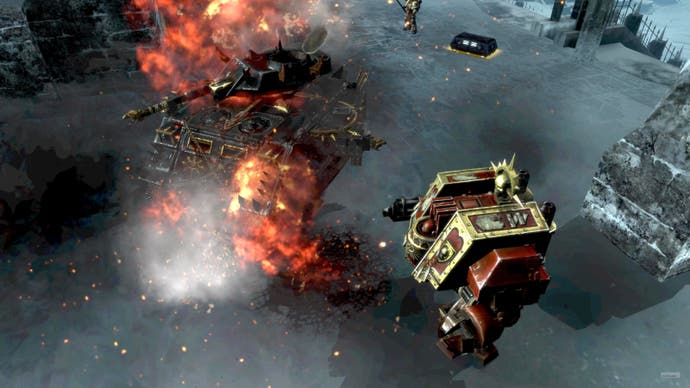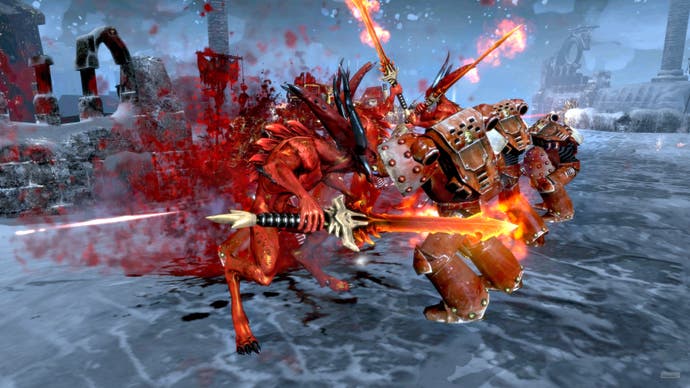Warhammer 40,000: Dawn of War II - Chaos Rising
Mild chaos, turning heavier with a risk of thunder.
"We quite often make keeping pure a difficult thing to do," Lydell explains, "so you get to choose how hard or how easy things will be, but there's a fair bit of middle ground in there. Somebody who isn't really paying attention will end up in the middle of the meter - if you want to be very corrupt, or very pure, you have to work at it."
The reasons why you might want to be very corrupt or very pure lie in the traits unlocked by the Corruption bar. Essentially bolt-on abilities for your characters, independent of its levels (the level cap, by the way, rises from 20 to 30, with each of the skill trees extending correspondingly), these are interesting abilities which all have unique trade-offs in their power. You might, for example, get a powerful new attack - but when you use it, it drains your own health.
The Corruption meter allows Relic to add even more customisation to the game's RPG-style character sheets, but without adding too much extra complexity, since the decisions you make regarding Corruption come through the flow of play rather than being left for you to puzzle out on the character screen itself. It also hints strongly at Relic's other big change in Chaos Rising - a fundamentally new approach to how it creates missions.
This is another aspect where the team knew it had a weak point that needed addressing. "When we started hearing feedback about the Dawn of War II campaign being repetitive, the missions being repetitive... We just thought, okay, that's got to be one of the key things we try to improve," Lydell says.

To that end, while the length of the single-player campaign is quite respectable - "it's about the same length as the first Company of Heroes, around 15 hours" - the structure is quite different to DOW2. There are only 15 missions - significantly fewer - but each is more complex, boasting several key decision points (which often influence your Corruption score, depending on how you tackle them) and a host of sub-objectives which build to a climax. From Lydell's descriptions, it's a far cry from DOW2's somewhat-pedestrian structure of fighting through a dungeon and then beating a boss in every single level.
It's in this regard that the "expandalone" moniker seems more reasonable. You don't need a copy of the original Dawn of War II to play Chaos Rising, and owners of the two games will even be able to play against one another in multiplayer - but those who simply buy the "expansion" are unlikely to be disappointed given the enormous campaign being promised.
Moreover, Relic is considering those who come to the game fresh, without a DOW2 save from which to generate their Blood Raven squad. There'll be default settings which allow you to jump in with pre-generated characters, although Lydell does caution that the learning curve will be a touch steep for newcomers.

Of course, no expansion would be complete without some extra units to play with in multiplayer - yet on that front, Lydell remains tight-lipped. The Chaos race, of course, will be playable, and we know that the Space Marines are getting their hands on a new unit in the form of the Librarian, a caster class with a very unusual skill-set of customisable spells. As for the other units, Lydell is happy to let Warhammer 40,000 fans speculate away.
Less than a year on from the launch of Dawn of War II, the game still looks fantastic and is warmly liked by the strategy gaming contingent - and Relic seems determined to strike while the iron is hot, delivering a follow-up which goes well beyond what most gamers expect from an expansion, while not quite being a sequel in its own right either.
For Warhammer fans, the hook is obvious - the Blood Ravens go toe to toe with the Chaos forces on an unstable ice planet. For strategy fans, Relic promises a more compelling foe, a vastly improved campaign structure, more depth and exciting new units, all on top of what was already a great game.
Warhammer 40,000: Dawn of War II - Chaos Rising is due out for PC next year.


